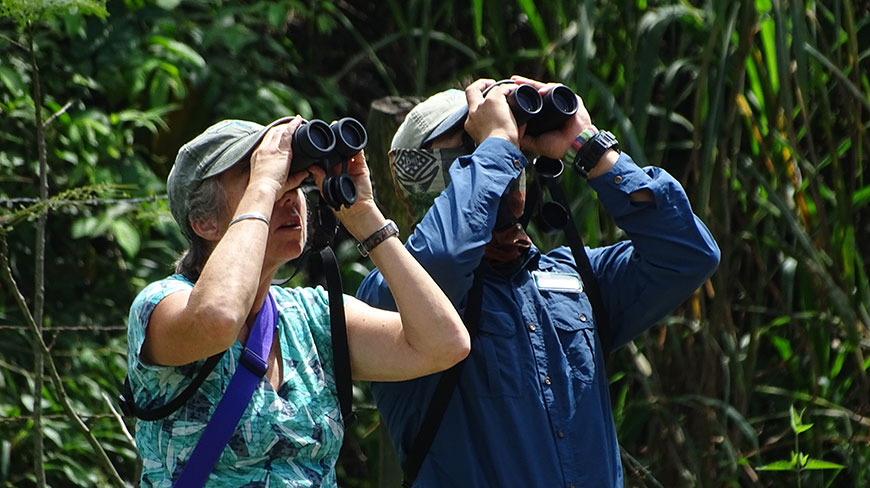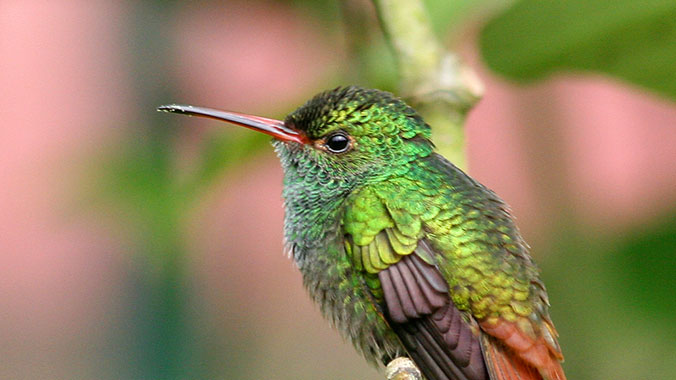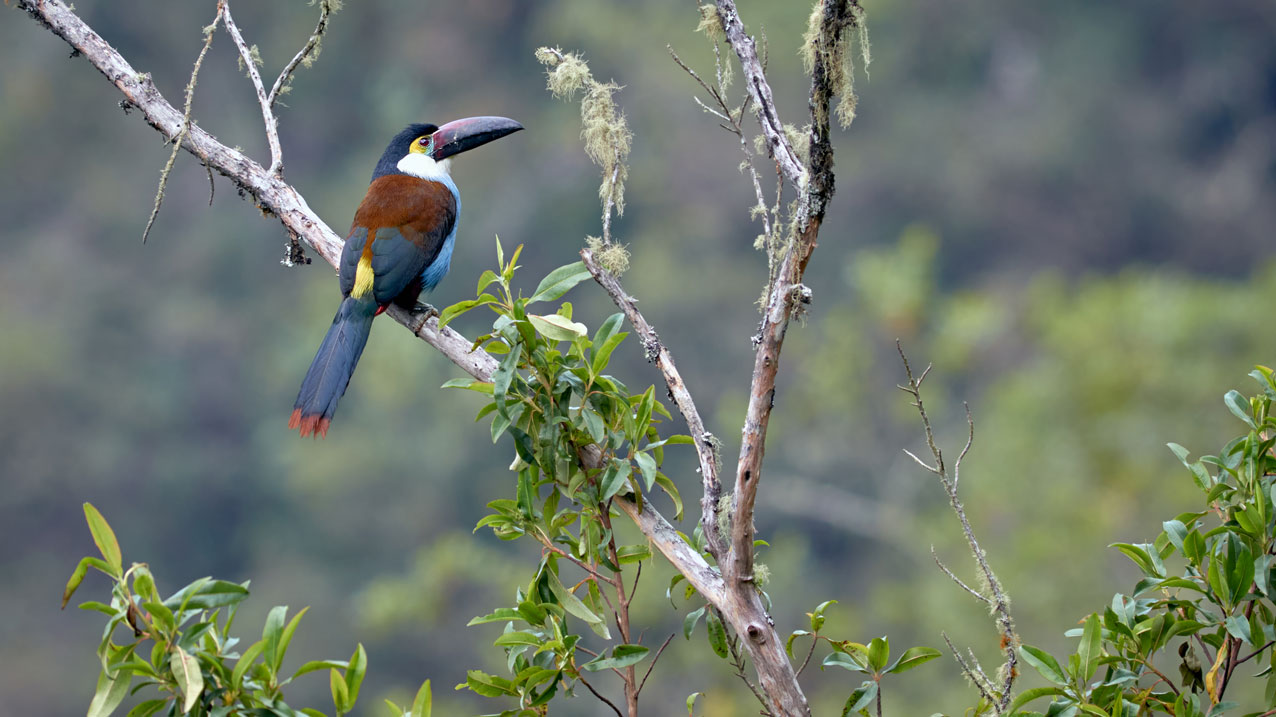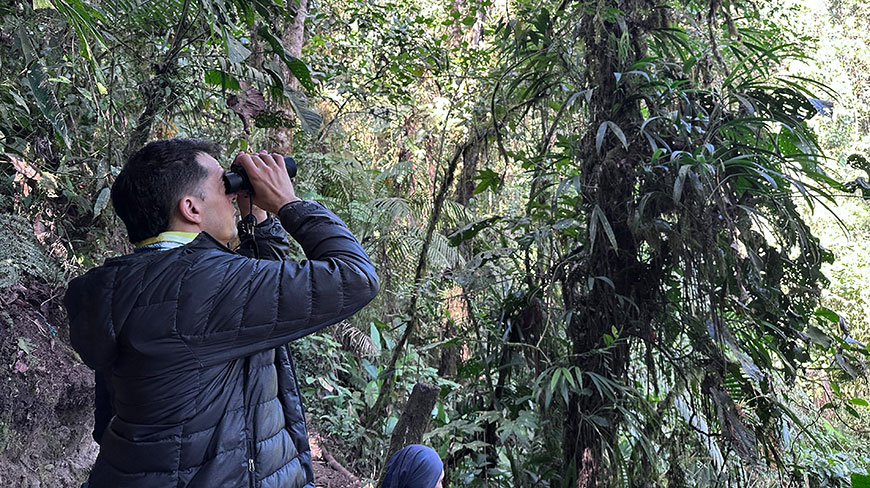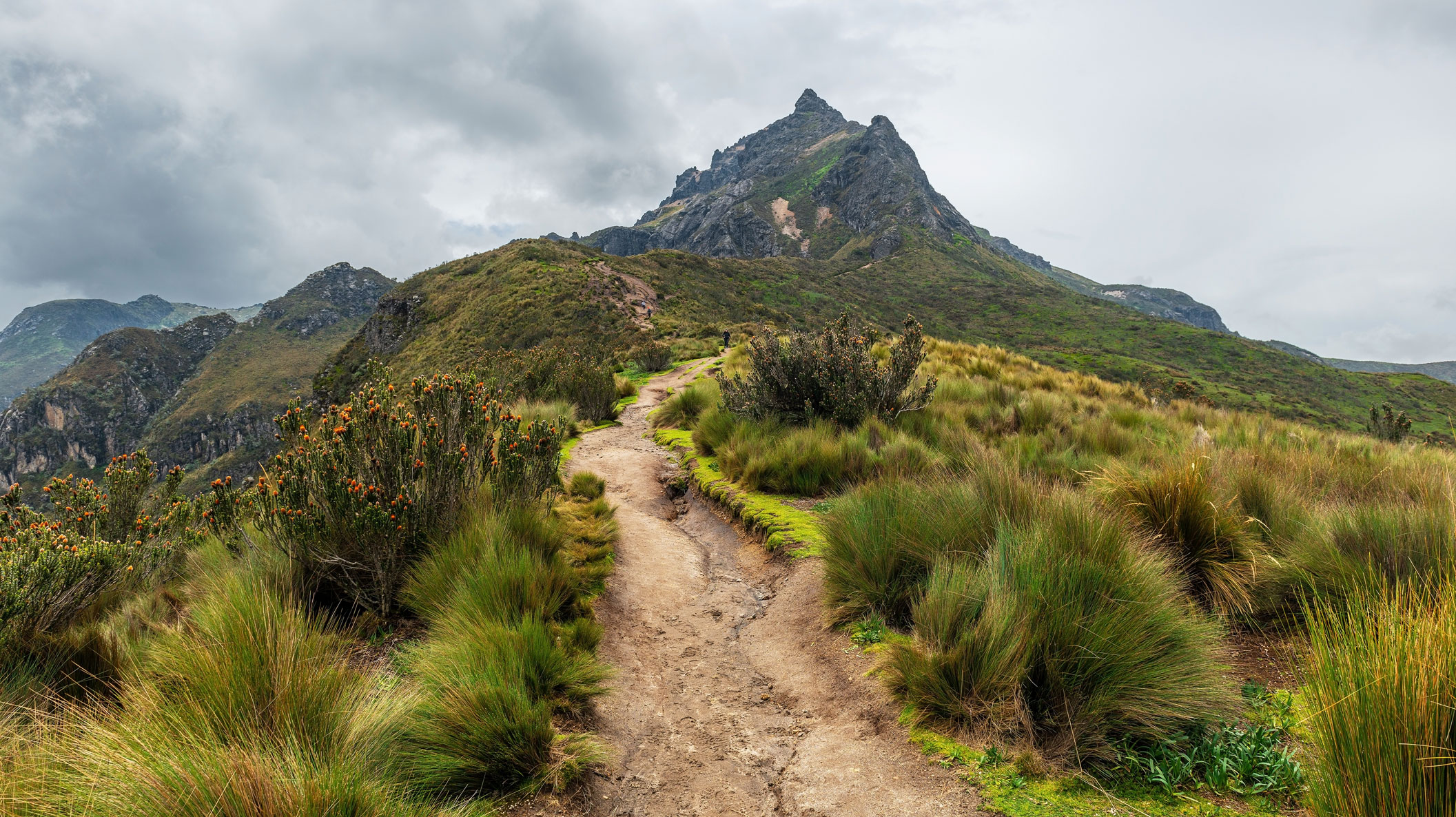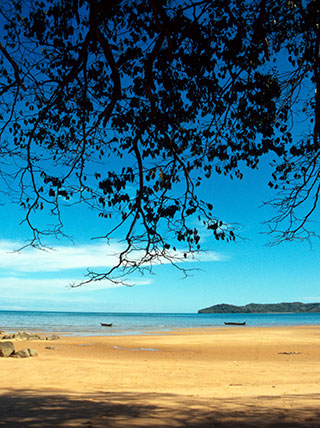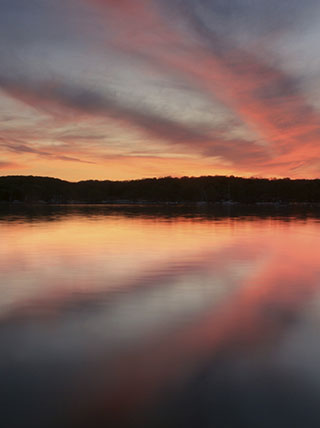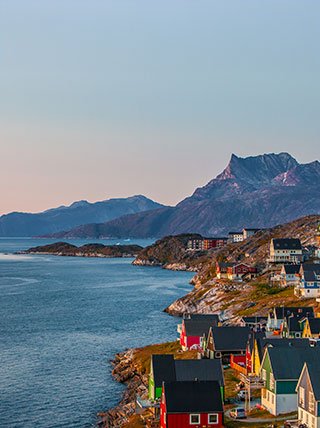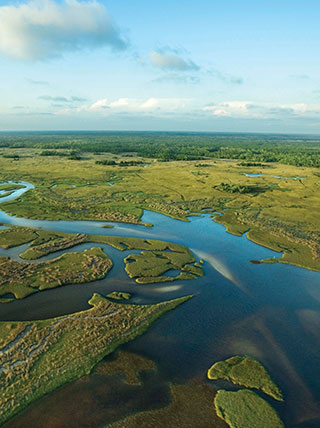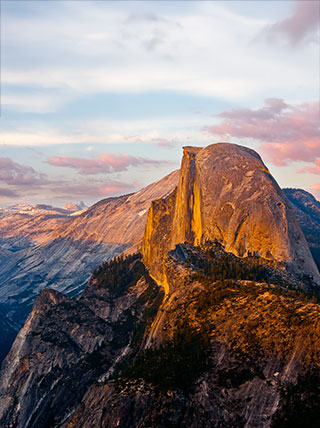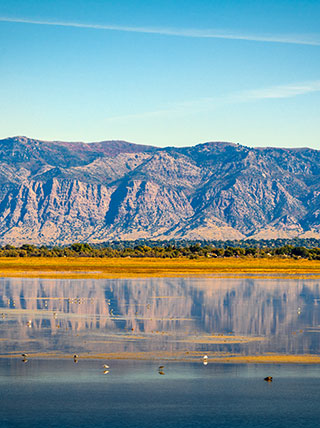Ecuador
Birding in the Ecuadorian Andes
Program No. 21607RJ
Go off the beaten path to explore the pristine environments of the Ecuadorian Andes, where you’ll join experts to spot a wealth of rare birds, including the stunning Cock-of-the-Rock!
Enroll with Confidence
We want your Road Scholar learning adventure to be something to look forward to—not worry about. Learn more
Protecting the Environment
We offset a portion of the emissions created by your travel. Learn more
Itinerary
While we make every effort to ensure the accuracy of our published materials, programs are typically advertised more than a year prior to their start date.
Read More.
While we make every effort to ensure the accuracy of our published materials, programs are typically advertised more than a year prior to their start date. As a result, some program activities, schedules, accommodations, personnel, and other logistics occasionally change due to local conditions or circumstances. Should a major change occur, we will make every effort to alert you. For less significant changes, we will update you during orientation. Thank you for your understanding.
Duration
11 days
10 nights
What's Included
28 meals (
10B, 9L, 9D
)
1 expert-led lecture
14 expert-led field trips
1 hands-on experience
An experienced Group Leader
10 nights of accommodations
Taxes and customary gratuity
Road Scholar Assurance Plan
Day
1
In Transit to Program, Arrive Quito
Location:
Quito
Stay:
Sheraton Quito Hotel
Activity Note
Hotel check-in from 3:00 p.m. Elevations in Quito range from 9,223 ft - 9,883 ft. To minimize your chances of experiencing altitude sickness, try to get plenty of rest before you travel, stay hydrated, avoid alcohol and fatty foods, eat high carbohydrate foods, and avoid strenuous exercise at high elevations. See your program’s "Getting There" section regarding transfers.
Evening:
At leisure. After checking in to the hotel and getting your room, settle in and get a good night’s rest for the day ahead.
Day
2
Parque de Guápulo, Ecuador Birds, Colonial Quito
Location:
Quito
Meals:
B,L,D
Stay:
Sheraton Quito Hotel
Activity Note
Getting on/off a bus; driving about 5 miles, approximately 1/2 hour riding time. Walking up to 1 mile; undulating and unpaved trail conditions at leisurely pace to acclimate to high elevation in Quito and the Andes. The air-conditioned Road Scholar bus does not have a bathroom on board, but we will have rest stops that help to break up travel times. Elevations from 9,223 to 9,883 feet.
Breakfast:
6:00 a.m. at the hotel with our Group Leader.
Morning:
Orientation: 6:30 a.m. at the hotel. The Group Leader will greet everyone and lead introductions. We'll review the up-to-date program schedule & any changes, discuss roles & responsibilities, logistics, safety guidelines, emergency procedures, & answer questions. Our Group Leader is a trained birding expert who will lead field trips & give educational presentations. Meals on our program feature local cuisine. Unless otherwise specified, transportation during your program will be provided by air-conditioned bus. Our buses do not include onboard toilets, so we've scheduled stops during drives for bathroom breaks. Free time is reserved for your personal independent exploration. Please note that program activities, schedules, and personnel may need to change due to local circumstances. In the event of changes, we'll alert you as quickly as possible. Thank you for your understanding. Then we'll board a bus with our Group Leader & ride to Parque de Guápulo, known for its high volume & diversity of bird species. Some of the species typically seen here include the Eared Dove, Great Thrush, Sparkling Violetear, Rufous-collared Sparrow, Blue and White Swallow, Tufted Tit-Tyrant, & Black-tailed Trainbearer. During our field trip, we'll also have an opportunity to enjoy views of Quito’s surrounding valleys. Next, we'll ride to the city center for a walking field trip to become familiar with Ecuador's capital. The architecture found in Quito’s historical center is a great example of the Baroque style that is a fusion of Spanish, Moorish, Flemish, & Indigenous art. We'll begin at La Basilica Church & continue to Independence Square, site of the Presidential House, the Bishop’s Palace, & the Cathedral. We'll explore the beautiful La Compañía Church to view its lavish, gold-covered interior. We’ll also stop at the San Francisco Church & convent, one of Quito’s oldest churches built on the site of a pre-Hispanic trading center.
Lunch:
At a local restaurant.
Afternoon:
Next, we’ll ride to the home of Ecuador’s prominent ornithologist and bird illustrator, Juan Manuel Carrion, in the Cumbaya Valley. Mr. Carron will give us a presentation on the birds of Ecuador and then let us explore his gardens and visit his atelier. We’ll then ride back to the hotel. Before dinner, we'll gather together for our first review of our birding checklist and have a briefing on tomorrow’s schedule.
Dinner:
At the hotel.
Evening:
At leisure. Prepare for early morning check-out and transfer tomorrow morning.
Day
3
Birding Along the Yanacocha & Quinde Eco-Route
Location:
Mindo
Meals:
B,L,D
Stay:
Sachatamia Lodge and Rainforest Reserve
Activity Note
Getting on/off a bus; about 81 miles, approximately 3.5 to 4 hours riding time. Walking up to 1.5 mile at Yanacocha; mostly flat but undulating and unpaved trail conditions at some places; elevation 10,500 to 11,500 ft. with average temperature 55F.
Breakfast:
6:00 a.m. at the hotel.
Morning:
Early this morning (6:45 a.m.), we will check out of the hotel, board a bus, and ride from Quito to Mindo via the Yanacocha and Quinde Eco-route for birding. This is one of Ecuador’s most important birding routes because of its varied ecosystems and microclimates (elevation range 10,500 to 11,500 feet). Yanacocha’s moss-clad temperate forest and polylepis woodland are located on the side of the Pichincha Volcano. This is the last refuge of the critically endangered Black-breasted Puffleg. An en route stop in the Yanacocha Reserve will give us an opportunity to walk along the main trail to reach the hummingbird garden feeders. Species commonly found at this location include the Black-chested and Scarlet-bellied Mountain-Tanagers, the Golden-breasted and Sapphire-vented Pufflegs, the Great Saphirewing and Sword-billed Hummingbird. During our field trip, our Group Leader will talk about the Jocotoco Foundation, one of Ecuador’s most recognized conservation organizations, and their work. In the early 1990’s the land was purchased by the Jocotoco Foundation, and Yanacocha Reserve was established as a protected reserve to combat the habitat loss driving the endangered Black-breasted Puffleg to extinction.
Lunch:
At a restaurant in the Yanacocha Reserve.
Afternoon:
We will continue our ride through the Eco-route with birding stops along the way. Look for Toucan Barbets, Plate-billed Mountain Toucans, and Beautiful Jays. As we head into lower elevations, we will begin to enter subtropical forests where we might see Blue-winged Mountain Tanagers and White-winged Brush Finches. Upon arrival in Mindo, we will check in to our hotel.
Dinner:
At the hotel.
Evening:
At leisure.
Day
4
Mashpi - Amagusa Reserve, Chocó-Andean Foothills
Location:
Mindo
Meals:
B,L,D
Stay:
Sachatamia Lodge and Rainforest Reserve
Activity Note
Getting on/off a bus; about 22 miles, approximately 1 hour riding time. Walking about 1 mile; mostly flat, unpaved road. Elevations at Mashpi Forest 2,300-5,000 feet.
Breakfast:
6:00 a.m. at the hotel.
Morning:
We’ll set out early this morning (6:30 a.m) by bus and ride to the Mashpi - Amagusa Reserve. There, our Group Leader will take us on a birding field trip, walking along the unpaved main access road through the forest in search of target species. Mashpi was recently declared a protected area and is among one of the best sites in Ecuador to see Choco Endemic birds. Among the species often seen in this area are the Dark-backed Wood-Quail, the Rose-faced Parrot, the Banded Ground-Cuckoo, the Purple-bibbed Whitetip, the Empress Brilliant, the Toucan Barbet, the Brown Inca, and the Indigo Flowerpiercer. At the reserve we will also visit the tanager and hummingbird miradors.
Lunch:
At a restaurant in the reserve.
Afternoon:
We’ll continue our birding field trip in the Chocó-Andean Foothills. With numerous habitats that are home to hundreds of species, the Choco lowlands are among the country’s best for birding. A number of these species are endemic to the sloping lowlands. We will ride back to the hotel at the end of our field trip.
Dinner:
At the hotel.
Evening:
At leisure.
Day
5
Pedro Vicente Maldonado, Birding in the Rio Silanche Reserve
Location:
Mindo
Meals:
B,L,D
Stay:
Sachatamia Lodge and Rainforest Reserve
Activity Note
Getting on/off a bus; driving about 50 miles, approximately 1.5 hours riding time. Walking up to 2 miles; mostly flat terrain, paved and unpaved surfaces, potentially muddy trail conditions. Ascending/descending steps at observation tower; about 45-feet tall. Average elevation 1,000 feet.
Breakfast:
Boxed breakfast en route.
Morning:
We’ll board the bus at 5 a.m. with our Group Leader and ride to Pedro Vicente Maldonado for a full day of birding in the Rio Silanche Reserve. The reserve protects one of the region’s last accessible stretches of hilly lowland forest. At elevations from 984 to 1,148 feet, this is a prime birding locale. Here it should be possible to view many important Chocó regional endemics as well as bird species that can normally be found in some hard-to-reach areas such as the Esmeraldas province or in neighboring Colombia. We will look for Purple-chested Hummingbirds, Chocó Trogons, Double-banded Graytails, Griscom’s Antwrens, Stub-tailed Antbirds, Black-tipped Cotingas, Slate-throated Gnatcatchers, Scarlet-breasted Dacnis, Scarlet-and-white Tanagers, and Blue-whiskered Tanagers.
Lunch:
At a local restaurant and mirador in the San Miguel de los Bancos area.
Afternoon:
We’ll continue birding around the fruit and nectar feeders at Mirador Rio Blanco. Popular species often spotted at the feeders include Silver-throated and Golden Tanagers, Orange-billed Sparrows, Rufous-tailed Hummingbirds, Green-crowned Brilliants, Rufous Motmots, Black-cheeked Woodpecker and more. Once we are done birding, we’ll board the bus and ride back to the hotel.
Dinner:
At the hotel.
Evening:
At leisure. Make it an early night to prepare for tomorrow's early morning birding activities. Prepare for check-out and transfer in the morning. As the departure will be very early in the morning, please settle your account (if needed) with the lodge this evening.
Day
6
Paz de las Aves Reserve, Mindo-Nambillo Protected Forest
Location:
Quijos Valley
Meals:
B,L,D
Stay:
Cabañas San Isidro
Activity Note
Getting on/off a bus; driving about 136 miles, approximately 4.5 hours riding time. Walking up to 1 mile; unpaved secondary roads, undulating and potentially muddy trail conditions. Elevation at Paz de las Aves & San Isidro 6,500 feet. Driving through Continental Divide elevations ranging from 3,870 to 13,500 feet.
Breakfast:
4:30 a.m. at the hotel, coffee, assorted pastries and fruit. Full breakfast will be later in the morning at Paz de las Aves.
Morning:
We will check out and begin our journey at 5 a.m. to Paz de las Aves Reserve near Nanegalito. Our Group Leader will take us on a birding field trip through the reserve that will include a visit to the cock-of-the-rock lek. Paz de las Aves was founded by Angel Paz, a local resident who decided to convert his property into an antpitta and cock-of-the-rock sanctuary. The reserve has slowly gained fame among birding circles since it is a great place in which to spot at least three species of antipittas including the Great, Yellow-breasted, and Moustached Antpitta. Other notable birds spotted in the sanctuary include Crested and Golden-headed Quetzals, Dark-backed Wood Quails, Cloud-forest Pygmy Owls, Black-chinned Mountain Tanagers, Crymson-rumped Toucanets, and Empress Brilliants. Next, we will ride through the Mindo-Nambillo Protected Forest. Approximately 400 species have been recorded in this region including Sunbitterns and Spotted Woodcreepers. Stops en route will give us opportunities to search for birds along secondary roads.
Lunch:
At a local restaurant and mirador. Fruit and nectar feeders situated beyond the dining area regularly attract hummingbirds, euphonias, tanagers, and more.
Afternoon:
We will reboard the bus and continue our ride to the Quijos Valley driving through the Continental Divide. We will go through the Simon Bolivar Avenue, then connect with the Via Interoceanica to Pifo. From there, the road will climb steadily up to the continental divide before it makes a dramatic descent, passing through the small towns of Papallacta and Cuyuja. Our scenic journey will continue through Baeza and Cosanga until we reach our lodge in the San Isidro Reserve. Once we arrive at the lodge, we’ll check in and settle in to our rooms.
Dinner:
At the lodge.
Evening:
At leisure. Spend time with fellow Road Scholars or just relax.
Day
7
Birding in the San Isidro Reserve
Location:
Quijos Valley
Meals:
B,L,D
Stay:
Cabañas San Isidro
Activity Note
Walking up to 2.5 miles; irregular terrain, some inclines, potentially muddy trail conditions. Elevations 6,100 to 7,900 feet.
Breakfast:
At the lodge.
Morning:
We’ll set out walking with our Group Leader for full day of birding activities in the San Isidro Reserve and depart our lodge at 8:45 a.m. The reserve serves as an important biological bridge between the Antisana and Gran Sumaco Reserves. Forest trails lead through different elevations and habitats ranging from lower temperate to subtropical zones. Regularly seen species include the Yellow-bellied Chat-Tyrant, Rufous-headed Pygmy Tyrant, Green-and-black Fruiteater, Rufous Wren, Grass-green Tanager, and Hooded Mountain Tanager. Some exciting species we will hope to encounter include Crested Quetzal, Black-billed Mountain Toucan, Emerald-bellied Puffleg, Barred Antthrush, Greater Scythebill (rare), White-faced Nunbird (very rare), Dusky Piha, and White-rimmed Brush-Finch. Regular visitors to the reserve’s hummingbird feeders include Sparkling Violetears, Speckled Hummingbirds, Chestnut-breasted Coronet, Fawn-breasted Brilliants, and Long-tailed Sylphs.
Lunch:
At the lodge.
Afternoon:
Our birding field trip in the San Isidro Reserve will continue. We’ll then take part in a local reforestation project, helping to plant indigenous trees such as the lucuma that are in danger of extinction. Lucuma trees are native to the Andean highlands of Peru, Chile, Ecuador, and Colombia and the fruit they produce are used widely in local desserts. Once we are done digging and preparing the soil, we’ll plant the trees and affix metal identification tags to each plant. This will make it easier to document what has been planted and monitor plant growth over time. If we ever return, we’ll be able to check on the progress of the trees we planted. We’ll return to the hotel after our field trip.
Dinner:
At the lodge.
Evening:
At leisure.
Day
8
Birding in Narupa Reserve, Rio Hollin Mirador & Baeza Bypass
Location:
Quijos Valley
Meals:
B,L,D
Stay:
Cabañas San Isidro
Activity Note
Getting on/off a bus; driving about 80 miles, approximately 2.5 hours riding time. Walking about 2.5 miles; irregular terrain, gradual inclines, potentially slippery trail conditions. Elevations at Narupa Reserve 3,200 - 5,200 feet.
Breakfast:
5:30 a.m. at the lodge.
Morning:
Early in the morning we’ll drive through the Guacamayos mountain range to reach the Cocodrilos Community to explore the Narupa Reserve. This is the nonbreeding ground for migratory birds such as the Cerulean Warbler, Canada Warbler and the Swainson's Thrush. At the bird feeders we'll be able to observe several species of tanagers, flycatchers, and hummingbirds. Narupa reserve was established in 2006 by Jocotoco Foundation with the aim of protecting the lower montane evergreen forest that are threatened by deforestation for agricultural purposes. The long-term goal of the foundation is to establish connectivity with the Sumaco-Napo Galeras National Park and the Antisana Ecological Reserve by expanding the reserve. This connectivity plan would help conserve the habitat of globally threatened species such as: Harpy Eagle, Black Tinamou, Cerulean Warbler, Foothill Elaenia, Military Macaw, Coppery-chested Jacamar & the Orange-breasted Falcon. The only known nesting site for the endangered Orange-breasted Falcon in Ecuador was on a cliff adjacent to the reserve. We will continue to Rio Hollin Mirador where we'll have the chance to spot Golden-tailed Sapphires, Black-throated Brilliants, Gould’s Jewelfronts, Wire-crested Thorntails, White-tailed Hillstars among other species. We’ll return to the lodge after our field trip.
Lunch:
At the lodge.
Afternoon:
Next, we’ll ride to the Baeza Bypass and make intermittent birding stops along the way. We will look for species such as the Black-billed Thrush, Red-breasted Blackbird, Blue-necked Tanager, Yellow-browed Sparrow, Russet-backed Oropendola, and Marble-faced Bristle Tyrant, then, return to the lodge.
Dinner:
At the lodge.
Evening:
At leisure. Prepare for check-out and transfer tomorrow.
Day
9
Humid Temperate Forest, Elfin Forest, Transfer to Quito
Location:
Quito
Meals:
B,L,D
Stay:
Hosteria Rincon de Puembo
Activity Note
Getting on/off a bus; driving about 66 miles, approximately 2 hours riding time. Walking about 1/2 mile; garden paths, undulating terrain, rocky riverbank, potentially muddy trails. Elevation 8,900 feet.
Breakfast:
6 a.m. at the lodge.
Morning:
After checking out, we’ll board the bus and begin our transfer to Guango Lodge located at Ecuador’s eastern slope. This zone of humid temperate forest is home to a large variety of hummingbirds including Long-tailed Sylphs, Mountain Velvetbreasts, Collared Incas, White-bellied Woodstars, Sword-billed and Speckled Hummingbirds, Tourmaline Sunangels, Buff-tailed Coronets, Glowing Pufflegs, Green Violetears, and Tyrian Metaltails. Be on the lookout for Monked, Glossy, and White-sided Flowerpiercers that commonly frequent the area. Other birds frequently seen at Guango Lodge include the Andean Guan, Gray-breasted Mountain-Toucan, Turquoise Jay, Scarlet-bellied, Lacrimose, Buff-breasted and Hooded Mountain-Tanagers, Gray-hooded Bush-Tanager, Black-headed, Black-capped and Black-eared Hemispingus and Slaty Brushfinch.
Lunch:
At the lodge.
Afternoon:
We’ll continue birding on the lodge grounds, then board the bus for our drive to Puembo/Quito. Upon arrival, we will check in to the hotel with some time to freshen up and relax before dinner.
Dinner:
At the hotel.
Evening:
At leisure.
Day
10
Birding in Antisana Ecological Reserve
Location:
Quito
Meals:
B,L,D
Stay:
Hosteria Rincon de Puembo
Activity Note
Getting on/off a bus; driving about 110 miles, approximately 3 hours riding time. Walking about 1.5 miles; paved roads, undulating grassy trails. Highest elevation reached is 12,850 feet.
Breakfast:
6 a.m. at the hotel.
Morning:
We will board the bus and ride to Antisana Ecological Reserve for a bird-watching field trip. The privately-owned Antisana Ecological Reserve lies between the eastern border of the Andes and the Amazon lowlands; sandwiched midst the Cayambe-Coca Ecological Reserve and Sumaco Napo Galeras National Park. The reserve’s nearly 30,000 acres are a birdwatcher’s paradise with ecological zones ranging from lowland rainforest to páramo at an elevation of 18,886 feet. Birds typically found at this site include the Andean Condor, Giant Hummingbird, Corunculated Cara Cara, Black-faced Ibis, Speckled Teal, Andean Duck, Silvery Grebe, Slate-colored Coot, Andean Gull, Andean Lapwing, and Aplomado Falcon.
Lunch:
At a local restaurant.
Afternoon:
Returning to the hotel, the remainder of the afternoon is free. Before dinner, we’ll gather for the last time for our final bird count.
Dinner:
At the hotel. Share favorite experiences and enjoy camaraderie with new Road Scholar friends during our farewell dinner.
Evening:
At leisure. Prepare for check out and departure in the morning. Participants with international flights departing very late tonight/pre-dawn in the morning will check out of the hotel and transfer to the Mariscal Sucre International Airport (UIO).
Day
11
Program Concludes, In Transit from Program
Location:
In Flight
Meals:
B
Activity Note
Check-out by 11:00 a.m. See your program’s "Getting There" section regarding transfers at the conclusion of the program.
Breakfast:
At the hotel (dependent on flight times). This concludes our program.
Morning:
If you are returning home, safe travels. If you are staying on independently, have a wonderful time. If you are transferring to another Road Scholar program, detailed instructions are included in your Information Packet for that program. We hope you enjoy Road Scholar learning adventures and look forward to having you on rewarding programs in the future. Don’t forget to join our Facebook page and follow us on Instagram. Best wishes for all your journeys!
Please select a day to update the map
Map details are not available for this location.

